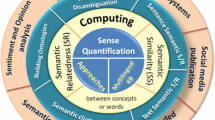Abstract
Expressive knowledge representations with flexible semantic similarity measures are central for the functioning of semantic information retrieval, information integration, matchmaking etc. Existing knowledge representations provide no or not sufficient support to model the scope of properties. While properties in feature- and geometric models always refer to the whole concept, structured representations such as the alignment model provide a limited support for scope by assigning properties to objects which are part of the whole entity. Network models do not support properties at all. In this paper we propose a hybrid model: a structured knowledge representation combining the relational structure of semantic nets with property-based description of feature- or geometric models. It supports to model properties—features or dimensions—and their scope by taxonomic or non-taxonomic relations between a concept and its properties. The similarity measure computes the similarity in consideration of the scope of each property.
Preview
Unable to display preview. Download preview PDF.
Similar content being viewed by others
References
Attneave, F.: Dimensions of Similarity. American Journal of Psychology 63, 516–556 (1950)
Devore, J., Peck, R.: Statistics - The Exploration and Analysis of Data. Pacific Grove, CA, Duxbury (2001)
Gärdenfors, P.: Some tenets of Cognitive Semantics. Cognitive Semantics: Meaning and Cognition. In: Allwood, J., Gärdenfors, P. (eds.), pp. 19–36. John Benjamins, Amsterdam (1999)
Gärdenfors, P.: Conceptual Spaces: The Geometry of Thought. MIT Press, Cambridge (2000)
Gärdenfors, P.: How to Make the Semantic Web More Semantic, Torino, Italy. Formal Ontology in Information Systems. IOS Press, Amsterdam (2004)
Gentner, D., Markman, A.B.: Structure Mapping in Analogy and Similarity. American Psychologist 52(1), 45–56 (1997)
Goldstone, R.L.: Similarity, Interactive Activation, and Mapping. Journal of Experimental Psychology: Learning, Memory, and Cognition 20(1), 3–28 (1994)
Goldstone, R.L., Medin, D.L.: Similarity, Interactive Activation and Mapping: An Overview. In: Barnden, J., New Jersey, H.K. (eds.) Advances in Connectionist and Neural Computation Theory, Ablex. Analogical Connections, vol. 2, pp. 321–362 (1994)
Goldstone, R.L., Son, J.: Similarity. In: Morrison, R. (ed.) Cambridge Handbook of Thinking and Reasoning. Cambridge University Press, Cambridge (2004)
Markman, A.B.: Knowledge Representation. Lawrence Erlbaum Associates, Mahwah (1999)
Melara, R.D., Marks, L.E., et al.: Optional processes in similarity judgments. Perception & Psychophysics 51(2), 123–133 (1992)
Rada, R., Mili, H., et al.: Development and application of a metric on semantic nets. IEEE Transactions on systems, man, and cybernetics 19(1), 17–30 (1989)
Raubal, M.: Formalizing Conceptual Spaces. Formal Ontology in Information Systems. In: Varzi, A., Vieu, L. (eds.) Proceedings of the Third International Conference (FOIS 2004), vol. 114, pp. 153–164. IOS Press, Amsterdam (2004)
Rodríguez, A.: Assessing Semantic Similarity Among Spatial Entity Classes. Spatial Information Science and Engineering. Maine, PhD Thesis. University of Maine, 168 (2000)
Rodríguez, A., Egenhofer, M.: Determining Semantic Similarity Among Entity Classes from Different Ontologies. IEEE Transactions on Knowledge and Data Engineering 15(2), 442–456 (2003)
Sattath, S., Tversky, A.: On the Relation Between Common and Distinctive Feature Models. Psychological Review 94(1), 16–22 (1987)
Schwering, A.: Semantic Neighbourhoods for Spatial Relations (Extended Abstract). In: Third International Conference on Geographic Information Science (GIScience), Maryland, USA, Regents of the University of California (2004)
Schwering, A., Raubal, M.: Spatial Relations for Semantic Similarity Measurement. In: 2nd International Workshop on Conceptual Modeling for Geographic Information Systems (CoMoGIS 2005), Klagenfurt, Austria. Springer, Heidelberg (2005 forthcoming)
Shepard, R.N.: Stimulus and Response Generalization: A Stochastic Model Relating Generalization to Distance in Psychological Space. Psychometrika 22(4), 325–345 (1957)
Shepard, R.N.: Stimulus and Response Generalization: Deduction of the Generalization Gradient from a Trace Model. Psychological Review 65(4), 242–256 (1958a)
Shepard, R.N.: Stimulus and Response Generalization: Tests of a Model Relating Generalization to Distance in Psychological Space. Journal of Experimental Psychology 55(6), 509–523 (1958b)
Smith, E.E.: Concepts and Induction. Foundations of cognitive science, M. I. Posner, pp. 501–526. MIT Press, Cambridge (1989)
Suppes, P., Krantz, D.M., et al.: Foundations of Measurement - Geometrical, Threshold, and Probabilistic Representations. Academic Press, Inc., San Diego (1989)
Tversky, A.: Features of Similarity. Psychological Review 84(4), 327–352 (1977)
Tversky, A., Gati, I.: Studies of Similarity. In: Rosch, E., Lloyd, B. (eds.) Cognition and Categorization, pp. 79–98. Lawrence Erlbaum, Hillsdale (1978)
Tversky, A., Gati, I.: Similarity, Separability, and the Triangle Inequality. Psychological Review 89(2), 123–154 (1982)
Author information
Authors and Affiliations
Editor information
Editors and Affiliations
Rights and permissions
Copyright information
© 2005 Springer-Verlag Berlin Heidelberg
About this paper
Cite this paper
Schwering, A. (2005). Hybrid Model for Semantic Similarity Measurement. In: Meersman, R., Tari, Z. (eds) On the Move to Meaningful Internet Systems 2005: CoopIS, DOA, and ODBASE. OTM 2005. Lecture Notes in Computer Science, vol 3761. Springer, Berlin, Heidelberg. https://doi.org/10.1007/11575801_32
Download citation
DOI: https://doi.org/10.1007/11575801_32
Publisher Name: Springer, Berlin, Heidelberg
Print ISBN: 978-3-540-29738-3
Online ISBN: 978-3-540-32120-0
eBook Packages: Computer ScienceComputer Science (R0)




